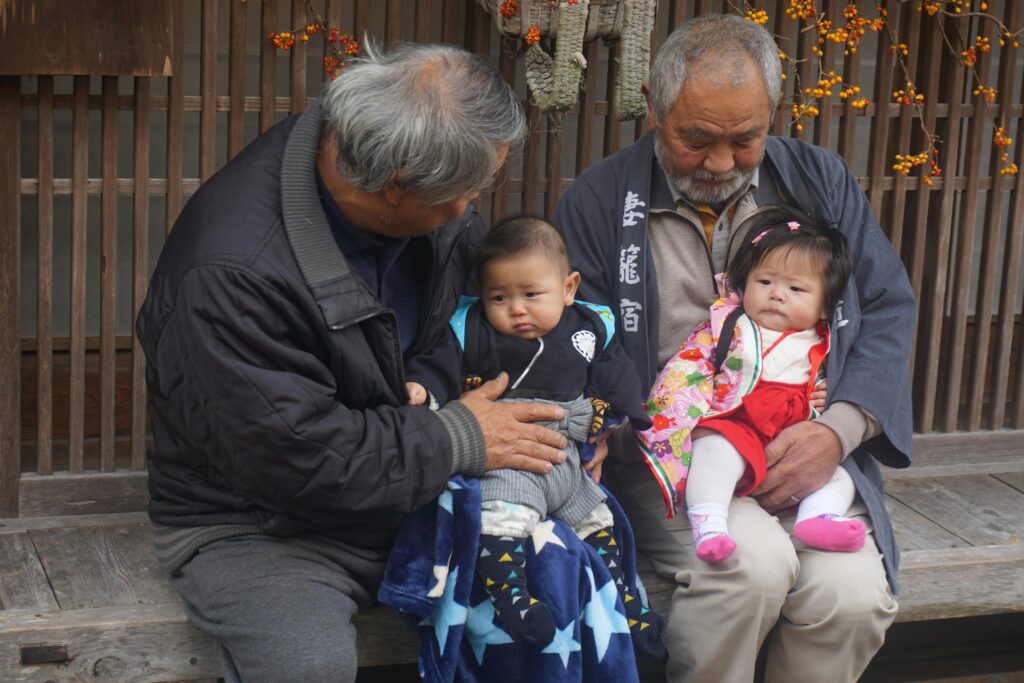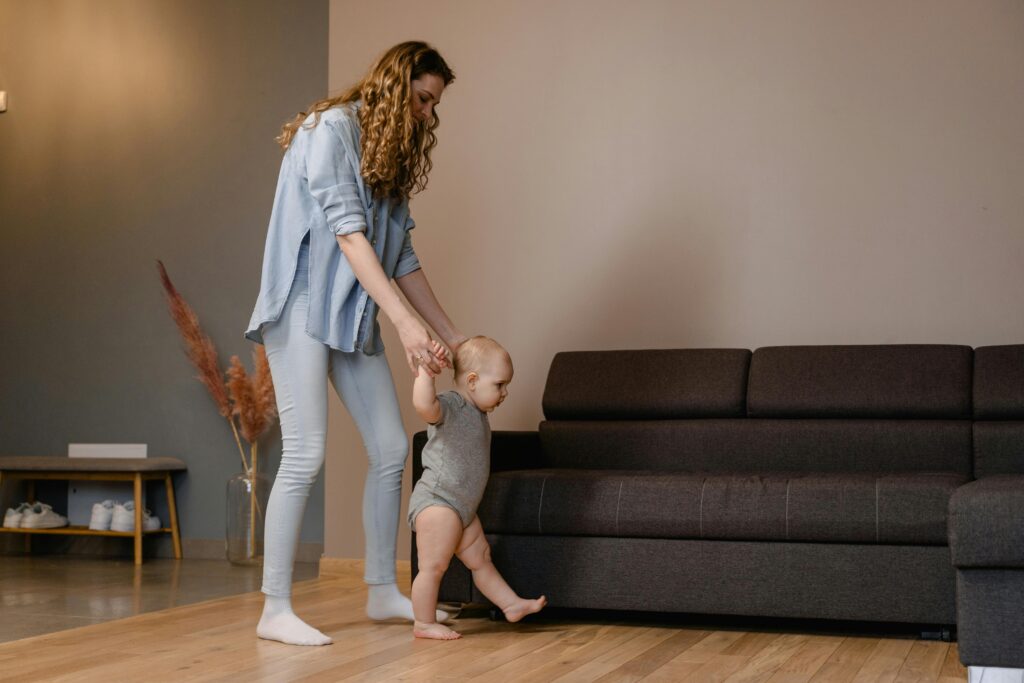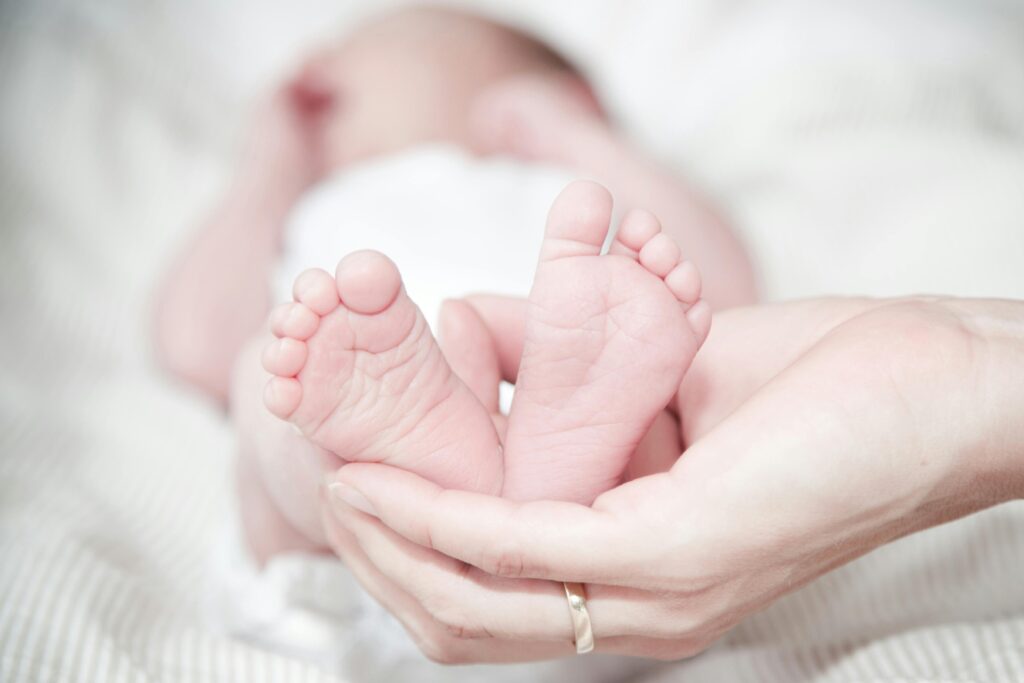A child’s existence is shaped by a succession of complex milestones that occur during infancy, making it a marvel of human development. Infants go off on a fascinating voyage of development, learning, and discovery the instant they are born. This in-depth investigation illuminates the extraordinary transformation from defenseless infant to inquisitive explorer by delving into the minute intricacies of developmental milestones during the first year of life.
Month One
As a baby leaves the safe haven of the womb and enters the wide outside world, the first month of life is a time of significant upheaval. Babies sleep during much of the day, only emerging briefly to eat and interact with caregivers in the most rudimentary ways. Their motions during this period are mostly reflexive, motivated by rudimentary instincts developed during fetal development. Aside from their powerful grip reflex, which causes them to cling tenaciously to objects placed in their palms, babies also have an innate tendency to move their heads toward light or sound. Infants can interact with faces and items held by caregivers because, even though their vision is still growing, they can usually focus on objects up to 8 to 12 inches away. During this time, skin-to-skin contact, such as kangaroo care, is quite helpful as it fosters bonding and helps to regulate the baby’s breathing, heart rate, and temperature.
Month Two
Babies show indications of heightened alertness and attentiveness as they approach their second month of life. They still rely heavily on their careers for help and food, but they are becoming more aware of their environment. They track objects with their eyes and turn their heads to follow sounds. The frequency of brief periods of consciousness increases, presenting chances for socialization and strengthening relationships with caregivers. Some babies may begin to show signs of early socialization, such smiling at familiar faces or comforting voices. In order to build the parent-child link and advance cognitive development, caregivers can encourage social interaction with their infant through activities like talking, singing, and maintaining eye contact.
Month Three
Infants show more mastery over their movements and social interactions by the third month. When positioned upright and supported, they are able to maintain a constant head position, indicating stronger neck muscles and better head control. Babies benefit greatly from tummy time as it helps them develop the muscles necessary for subsequent milestones like rolling over and crawling. As babies reach for and grab things in their line of sight, hand-eye coordination starts to develop, setting the stage for further exploration and manipulation. Age-appropriate toys and objects, such rattles, soft blocks, and textured toys, which aid in stimulating the senses and fostering cognitive and motor development, are a good way for caregivers to support this development in their infant.

Month Four
As babies become stronger and more coordinated in their movements, the fourth month marks the beginning of a major period of physical development. As they lie on their stomachs, many babies can now raise their heads and chests, setting the stage for later motor skills like sitting up and crawling. Babies that are more skilled at utilizing their bodies to investigate their surroundings are more likely to roll over from their tummies to their backs. In social situations, they become more involved and receptive, grinning and gurgling in response to caregiver interactions. By giving kids lots of chances for play and social interaction—including playing games like peek-a-boo—caregivers can help them develop socially and emotionally and improve the link between parent and child.
Month Five
Babies show more movement and dexterity by the time they are five months old. Many have the ability to sit for extended periods of time with support, giving them a fresh perspective on their environment. Babies’ hand-eye coordination keeps developing, allowing them to pick up and move items more precisely. A desire to chew on objects for comfort and increased drooling are two symptoms of teething that some babies may experience. Teething toys or cold teething rings, which assist relieve sore gums and teething pain, are two ways caregivers can ease discomfort during this time.
Month Six
Many newborns are able to sit unaided for brief amounts of time during this crucial milestone month. With this newfound ability, they can now explore their surroundings more freely and independently while seated. Additionally, some babies may begin to explore with crawling, first moving on their stomachs or pushing themselves backward. As infants learn that items exist even when they are hidden from view, object permanence develops, setting the stage for later cognitive skills. Playing simple games like hide-and-seek with toys or items can help caregivers encourage this cognitive development by reinforcing the concept of object permanence and fostering cognitive growth.

Month Seven
Babies start to explore their surroundings more daringly at seven months of age. Babies use their arms and legs to drive themselves forward while crawling, becoming increasingly intentional and coordinated in their pursuit of novel experiences. Early locomotor skills may also be shown by their beginning to pull themselves up to a standing position with the assistance of furniture or other items. Babies continue to develop their language skills as they babble long syllables that resemble conversational turn-taking. By conversing with their infant and reacting to their babble with words and gestures that enhance language acquisition and communication abilities, caregivers can encourage their child’s language development.
Month Eight
By the time they are eight months old, babies are more adept at using their motor skills and communicating. Many have no trouble crawling, and they might even start experimenting with independently getting to stand. Babies’ developing fine motor abilities enable them to pick up small things with a pincer hold, utilizing their thumb and forefinger. Babbling grows increasingly complex as newborns try generating sounds and phrases, experimenting with rhythm and intonation. By giving their baby toys with various textures and shapes to play with, caregivers can encourage this development by giving them opportunities for sensory exploration and fine motor play. These activities serve to activate the senses and advance the development of fine motor skills.
Month Nine
Babies rapidly improve their cognitive and social skills throughout the ninth month of life as they become more perceptive of their surroundings. As they play peek-a-boo or wave farewell, they start to comprehend basic commands and gestures, exhibiting a growing awareness of social interactions and cues. It’s possible for some kids to even make their first speech, however these are usually only basic noises like “mama” or “dada.” Infants’ motor abilities continue to develop as they become more adept at picking up small items and feeding themselves finger foods. In order to facilitate social and linguistic development, caregivers can read books, sing songs, and play interactive games with their infant. These activities also serve to foster cognitive, social, and emotional development.

Month Ten
Babies continue to investigate their surroundings at ten months old with a growing degree of independence and curiosity. Many are skilled crawlers who can confidently and deftly navigate their environment. Additionally, they might begin to try standing unassisted and use their increased mobility to investigate vertical areas and items. Babies’ language development quickens, and they pick up new words and gestures quickly. They frequently use these to communicate their needs and wants. By creating a language-rich environment, talking to their infant frequently throughout the day, identifying items and behaviors, and reacting to their attempts at communication, caregivers can encourage language development and the development of communication skills in their child.
Month Eleven
Babies are displaying a wide range of skills and abilities at eleven months old, indicating that they are about to enter toddlerhood. Most can stand for brief amounts of time without assistance, and some may even take their first hesitant steps, which signifies the beginning of independent walking. Babies’ vocabulary is growing and they are starting to put simple sentences together to convey more complex thoughts as language continues to develop. In terms of their social interactions, kids become more expressive and participatory, playing easy games and displaying fondness for known caregivers. In order to foster physical, cognitive, and social development, caregivers can support this development by offering opportunities for physical activity and exploration, such as supervised playtime in secure, open settings, and by fostering social connection with peers and other caregivers.
Month Twelve
As newborns get closer to their first birthday, the first year comes to a whirlwind of milestones. By the time they are twelve months old, many are skilled walkers, able to move around with more assurance and dexterity. Additionally, they might begin experimenting with basic gestures to interact and communicate with others, including blowing kisses or waving. Babies’ language development reaches new heights as they pick up a growing vocabulary of words and expressions that help them communicate more effectively. They gain social skills and improve their ability to navigate social situations and create relationships, which paves the way for their future emotional and social growth. By offering chances for play and discovery, such as imaginative play, art projects, and outdoor play, caregivers can facilitate this development and assist the physical, cognitive, social, and emotional growth of their charges.

In conclusion, a child’s first year of life is a time of remarkable growth and transformation, characterized by a series of complex milestones that influence the course of their development. Every stage of infancy, from the clumsy steps of the newborn to the self-assured strides of the maturing toddler, is a monument to the incredible flexibility and durability of the human spirit. A lifetime of learning, adventure, and discovery can be laid down by caregivers who recognize and celebrate these milestones and offer the support and encouragement required to foster their child’s growth and development.


